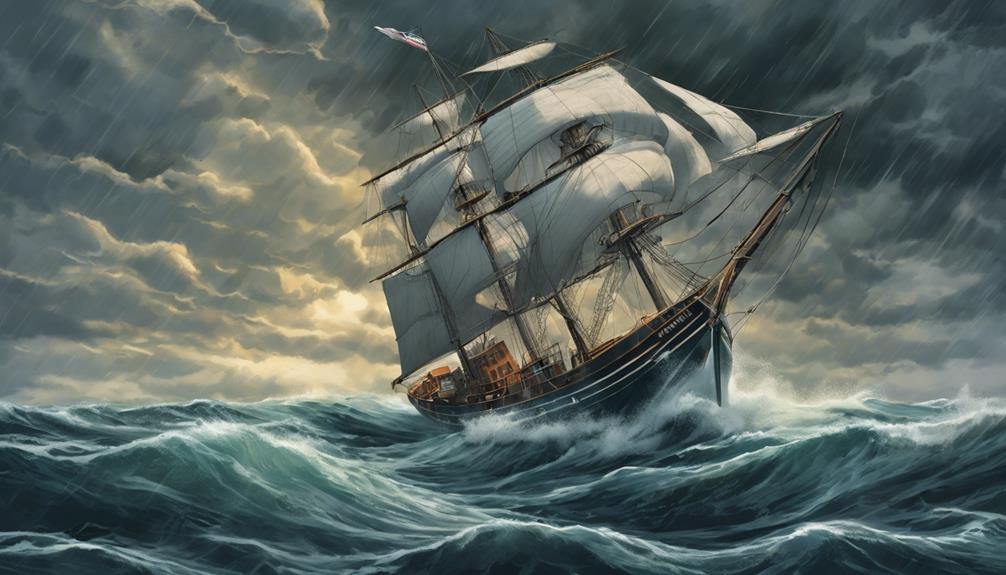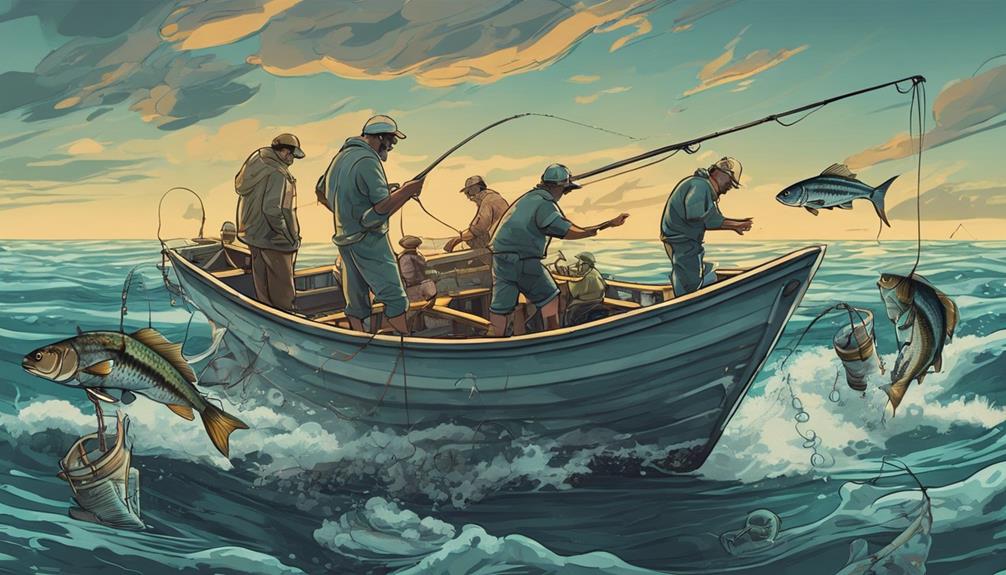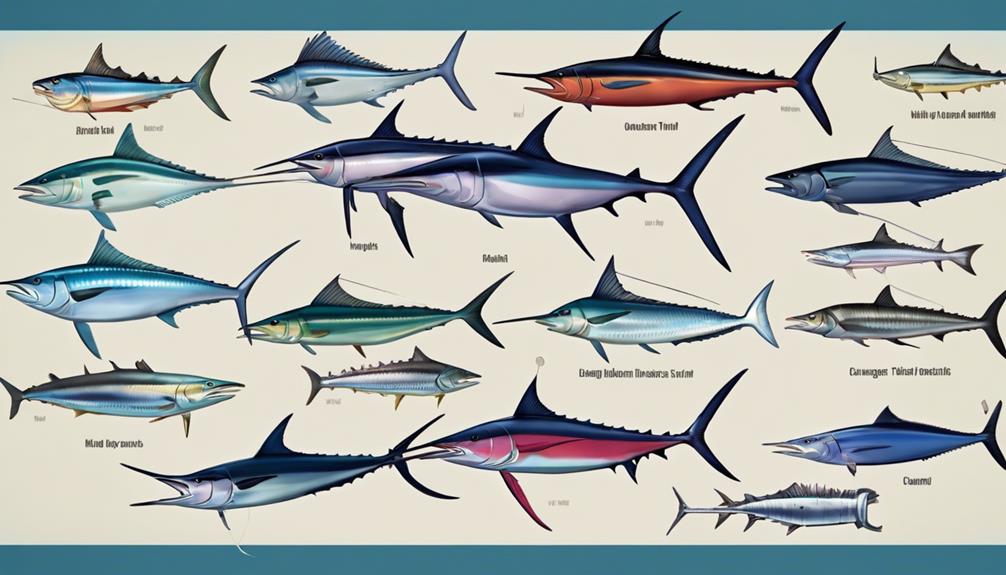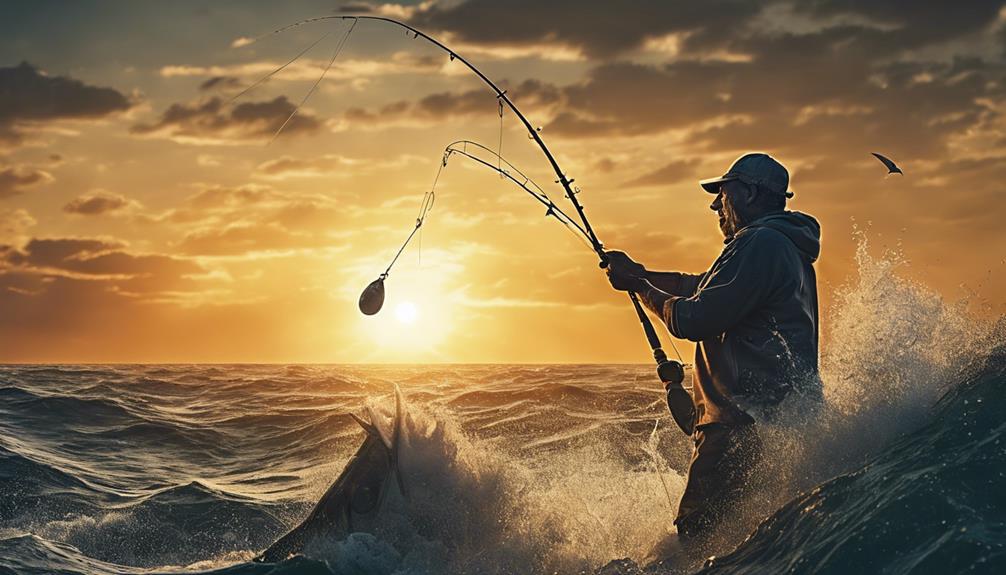When it comes to deep sea fishing, choosing the right location can significantly impact your success. Ensuring you are in the best spot is just the beginning of a successful outing.
But what about understanding the intricate dance of tides and currents? These nuanced factors play a crucial role in your fishing endeavors.
Imagine the thrill of mastering these strategies and reeling in that prized catch.
What other top tactics are essential for a fruitful deep sea fishing experience?
Choosing the Right Location
To maximize your chances of a successful deep-sea fishing trip, start by carefully selecting the ideal location. Researching depths is crucial in finding the right spot where the fish you're targeting are most likely to be found. Different species of fish prefer varying depths, so understanding the underwater topography can greatly improve your chances of a fruitful catch.
Local knowledge plays a significant role in choosing the right location for deep-sea fishing. Local fishermen or fishing guides are often the best sources of information when it comes to identifying the most productive fishing spots. They can provide insights into where the fish are biting, the best times to fish, and any particular underwater structures that attract fish.
Before heading out on your deep-sea fishing adventure, take the time to gather information from local sources. This could include talking to fishermen at the local marina, visiting bait and tackle shops, or joining online forums where fishing enthusiasts share tips and recommendations. By tapping into the knowledge of those familiar with the area, you can increase your chances of selecting a location that aligns with the type of fishing experience you desire.
Understanding Tides and Currents
Navigating the waters for successful deep-sea fishing requires a keen understanding of tides and currents. Tide patterns play a crucial role in determining your fishing success. As the tides change, they influence the movement and behavior of fish. During high tide, fish tend to move closer to shore or shallower waters to feed, making it an ideal time for fishing near the coastline. Conversely, low tide can concentrate fish in deeper areas, providing different opportunities for anglers. Understanding these patterns allows you to plan your fishing trips more effectively, increasing your chances of a successful catch.
Moreover, being aware of current effects is essential for catching fish. Strong currents can disorient fish and affect their feeding habits. In areas where currents are prevalent, such as around underwater structures or drop-offs, fish may gather to seek shelter or food. By positioning your bait strategically to account for the current flow, you can entice more bites and improve your overall fishing experience. Additionally, knowing how currents behave at different times of the day can help you predict where fish might be located, enabling you to target those areas efficiently.
Selecting the Proper Gear
Understanding the influence of tides and currents on fish behavior will guide your selection of the proper gear for successful deep-sea fishing. When it comes to selecting the right gear, two critical aspects to consider are gear maintenance and customization. Proper care of your equipment is essential for its longevity and optimal performance. Regularly cleaning and lubricating reels, checking rods for any signs of damage, and replacing worn-out lines are all part of gear maintenance that ensures your equipment is in top condition when you head out for a fishing trip.
Moreover, gear customization and personalization can significantly enhance your fishing experience. Choosing the right rod length, reel size, and line weight based on the type of fish you're targeting and the fishing conditions can make a significant difference in your catch rate. Additionally, customizing your gear to suit your preferences and fishing style can improve your comfort and overall success on the water.
Using Live Bait Effectively
For successful deep-sea fishing, mastering the art of using live bait effectively is crucial. When it comes to deep-sea fishing, the right bait presentation and hook size can make all the difference in attracting the big catches.
Here are some key tips to help you use live bait more effectively:
- Bait Presentation: How you present your live bait can significantly impact your success. Make sure the bait looks natural in the water to entice the fish. Consider using techniques like nose-hooking or tail-hooking to mimic natural movements.
- Hook Size: Choosing the appropriate hook size is vital when using live bait. The size of the hook should match the size of the bait to ensure a proper hookup. Using too large or too small of a hook can result in missed opportunities or lost catches.
- Live Bait Storage and Handling: Properly storing and handling live bait is essential for maintaining its freshness and effectiveness. Ensure your bait is kept in a well-oxygenated container with the right water temperature. Handle the bait gently to avoid damaging it before use.
Mastering Deep Sea Casting Techniques
To excel in deep sea fishing, honing your skills in mastering deep sea casting techniques is essential for reeling in those elusive catches. Improving accuracy and increasing distance in your casts can make a significant difference in your fishing success.
When focusing on improving accuracy, pay attention to your casting motion. Ensure that your movements are smooth and controlled, allowing you to place your bait precisely where you want it to be. Practice casting at different distances and targets to develop a keen sense of aim. By honing your accuracy, you increase the chances of enticing fish to strike.
In addition to accuracy, working on increasing your casting distance can help you reach those hard-to-reach spots where fish may be abundant. To achieve greater distance, utilize the power of your entire body in the casting motion. Shift your weight smoothly from your back foot to your front foot as you cast to generate more momentum. Timing your release with this weight transfer can propel your bait further out into the deep sea.
Patience and Persistence on the Water
Staying calm and maintaining focus while waiting for the perfect bite is crucial during your deep sea fishing excursions. Patience and perseverance are key virtues that will greatly enhance your deep-sea fishing experience.
- Patience: Deep sea fishing is a waiting game. It requires patience to endure long periods without any action. Remember, the fish are out there; it's just a matter of time before you get a strike.
- Perseverance: There will be moments of frustration when the fish aren't biting. It's essential to stay persistent and keep trying different techniques, baits, and locations. Your perseverance will pay off in the end.
- Mindset: Maintaining a positive mindset is crucial. Instead of getting discouraged, view the downtime as an opportunity to enjoy the serenity of the open water. Embrace the experience and stay focused on the thrill of the catch.
Adapting to Weather Conditions

When faced with changing weather conditions during deep sea fishing, adaptability becomes your greatest asset. Weather preparation and having the right equipment are crucial for a successful fishing trip. Before heading out, ensure you have checked the weather patterns and forecasts to anticipate any changes that may occur while you're on the water.
Having the appropriate gear for various weather conditions is essential. Make sure you have rain gear, extra layers for colder weather, and sun protection for when the sun is shining bright. It's also wise to have a reliable weather radio or a smartphone with a weather app to stay updated on any sudden changes.
As you navigate the waters, keep an eye on the sky and the water for any signs of incoming weather changes. Dark clouds, sudden temperature drops, or rough waves can indicate an approaching storm. If you notice any of these signs, consider heading back to shore to avoid getting caught in dangerous weather conditions.
Safety Tips for Deep Sea Fishing
During your deep sea fishing excursion, prioritize safety by following these essential tips. Ensuring your safety and that of your fellow anglers should be the top priority when heading out into the open sea. Here are some crucial safety tips to keep in mind:
- Emergency Procedures: Familiarize yourself with the emergency procedures on the boat before setting out. Know where the life jackets and emergency equipment are located, as well as how to use them. In case of an emergency, stay calm and follow the captain's instructions.
- Communication: Maintain clear communication with the captain and your fishing companions throughout the trip. If you feel unwell or notice any potential risks, don't hesitate to voice your concerns. Effective communication can help prevent accidents and ensure a smoother fishing experience.
- Proper Hydration, Sun Protection: Staying hydrated and protecting yourself from the sun are vital during a deep sea fishing trip. The combination of physical activity, sun exposure, and sea breeze can lead to dehydration. Drink plenty of water and wear sunscreen, sunglasses, and a hat to shield yourself from the sun's harmful rays.
Frequently Asked Questions
What Are Some Common Types of Fish Found in Deep Sea Fishing Locations?
When you head out for deep sea fishing, you'll encounter popular species like tuna, marlin, and swordfish. These fish are known for their size and fight, making them exciting catches.
Using techniques like trolling, jigging, or live bait fishing can help you reel them in successfully.
Deep sea fishing hotspots such as the Gulf of Mexico, the Bahamas, and Hawaii are known for abundant marine life, making them ideal locations for an unforgettable fishing experience.
How Can I Properly Maintain and Store My Fishing Gear to Ensure Longevity?
To properly maintain and store your fishing gear for longevity, keep it clean and dry after each use. Wipe down rods and reels with a damp cloth to remove salt and dirt.
Store them in a cool, dry place away from direct sunlight. Check for any signs of damage or wear regularly and make repairs as needed.
Proper storage and maintenance techniques will ensure your gear lasts for many successful fishing trips.
Are There Any Specific Regulations or Restrictions I Should Be Aware of When Deep Sea Fishing?
When deep sea fishing, it's crucial to be aware of fishing regulations and conservation efforts. These rules help protect marine life and ensure sustainable fishing practices.
Additionally, understanding safety precautions is essential for a successful trip. Regular equipment maintenance is key to keeping gear in top condition.
What Are Some Essential First Aid Supplies to Bring on a Deep Sea Fishing Trip?
When going deep sea fishing, it is important to pack essential first aid supplies for safety. Include items like bandages, antiseptic wipes, pain relievers, and seasickness medication in your kit.
Familiarize yourself with basic first aid techniques and emergency response procedures. Prioritize safety precautions to prevent injuries while out at sea.
Being prepared with the right supplies and knowledge can make a difference in handling emergencies during your fishing trip.
How Can I Best Prepare for Potential Seasickness While Out on the Water?
To prepare for potential seasickness while out on the water, consider using Seabands or medication. Additionally, try practicing breathing exercises and consuming ginger, known for its anti-nausea properties. These methods can help alleviate symptoms and make your deep sea fishing trip more enjoyable.
Remember to consult with a healthcare professional before taking any medication to ensure it's safe for you.
Conclusion
So, next time you head out for a deep sea fishing adventure, remember these top strategies for success.
Choose the right location, understand tides and currents, select the proper gear, use live bait effectively, master casting techniques, and be patient and persistent.
Don't forget to adapt to weather conditions and prioritize safety on the water.
With these tips in mind, you'll be well-equipped to have a successful deep sea fishing experience.
Happy fishing!



